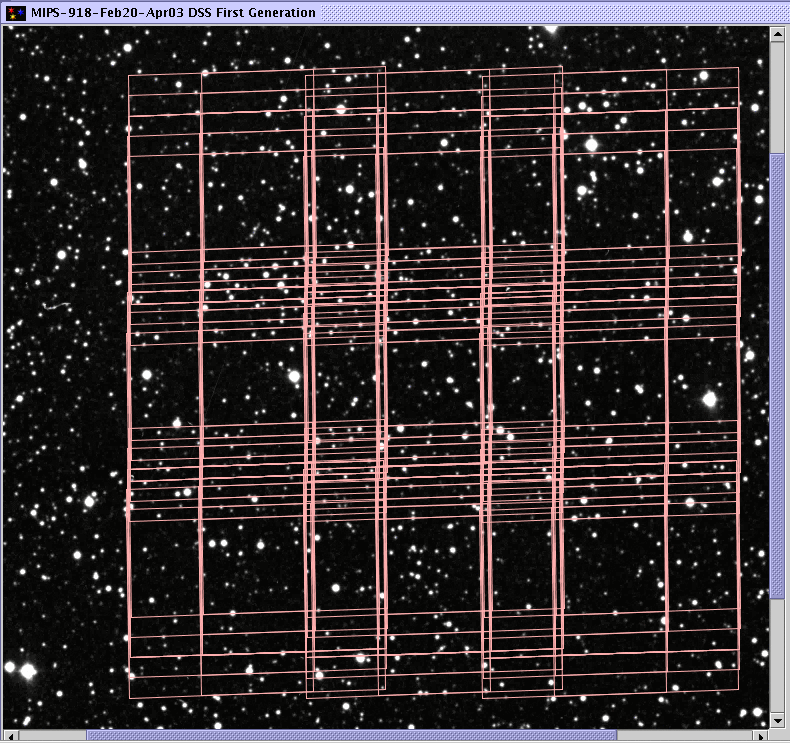Principal: Almudena Alonso
Deputy: David Frayer
Data Monkey(s): Almudena Alonso, David Frayer, Eiichi Egami
Priority:
Downlink Priority: Normal
Analysis Time: 24-48 hours
Last Updated:
Objective
To obtain a 70micron Routine Photometry IC
Description
We will obtain IOC acceptable routine 70um PHOTOMETRY
mode ICs (this task is repeated a number of times in different IOC campaigns)
to be used on a regular basis. This activity is a companion to the 70 um routine
SCAN IC task (MIPS-915). The pair of activities will allow us to determine
the relative efficiency and quality of ICs created using scan and photometry
AORs.
Since this task is repeated a number of times during IOC, we will observe
different regions of the sky each time. The task will check for possible variations
of quality of IC or saturation. This task will also be useful for screening
regions of the sky to obtain ICs in SIRTF routine operations. This task together
with MIPS-915 will determine whether routine ICs will be obtained in photometry
or scan mode.
This task is executed in:
MIPS Campaign G
MIPS Campaign H
MIPS Campaign I
MIPS Campaing K
Data Collected
A 3x3 square dither map (1 cycle) will be obtained at 70microns with 3 second
DCEs in a region of the sky chosen to avoid bright point sources. The offsets
are 300 arcseconds. At each position there will be 12 images, so a
total of 108 images will be produced each time this task is excecuted. The
map will require about 21.0 minutes of observing time. This is the AOR file
overlaid on the sky:

# Please edit this file with care to maintain the
# correct format so that SPOT can still read it.
# Generated by SPOT on: 8/15/2002 11:26:55
HEADER: FILE_VERSION=6.1, STATUS = PROPOSAL
AOT_TYPE: MIPS Photometry
AOR_LABEL: MIPS-918-Feb07-Mar22
AOR_STATUS: new
MOVING_TARGET: NO
TARGET_TYPE: FIXED CLUSTER - OFFSETS
TARGET_NAME: MIPS-918-Feb07-Mar22
COORD_SYSTEM: Equatorial J2000
POSITION1: RA_LON=5h19m37.90s, DEC_LAT=+3d54m01.5s
OFFSET_P2: EAST_ARRAY_V=300.0", NORTH_ARRAY_W=0.0"
OFFSET_P3: EAST_ARRAY_V=300.0", NORTH_ARRAY_W=300.0"
OFFSET_P4: EAST_ARRAY_V=0.0", NORTH_ARRAY_W=300.0"
OFFSET_P5: EAST_ARRAY_V=-300.0", NORTH_ARRAY_W=300.0"
OFFSET_P6: EAST_ARRAY_V=-300.0", NORTH_ARRAY_W=0.0"
OFFSET_P7: EAST_ARRAY_V=-300.0", NORTH_ARRAY_W=-300.0"
OFFSET_P8: EAST_ARRAY_V=0.0", NORTH_ARRAY_W=-300.0"
OFFSET_P9: EAST_ARRAY_V=300.0", NORTH_ARRAY_W=-300.0"
OFFSETS_IN_ARRAY: NO
OBSERVE_OFFSETS_ONLY: NO
OBJECT_AVOIDANCE: EARTH = YES, OTHERS = YES
MICRON_70: IMAGE_SCALE = DEFAULT, FIELD_SIZE = SMALL, EXPOSURE_TIME = 3, N_C
YCLES = 1
SPECIAL_OVERHEAD: IMPACT = none, LATE_EPHEMERIS = NO
RESOURCE_EST: TOTAL_DURATION=1306.4854, SLEW_TIME=121.4, SETTLE_TIME=117.98532,
SLEW_OVERHEAD=180.0, SPECIAL_OVERHEAD=0.0, UPLINK_VOLUME=4756, DOWNLINK_VOLUME=9
370224, VERSION=S6.1.2
INTEGRATION_TIME: MIPS_24=0.0,MIPS_70=37.748737,MIPS_160=0.0
COMMENT_START:
COMMENT_END:
Array Data Desired:
All Arrays
Data Reformatting Option:
- NORMAL
1 FITS file per AOR per array.
Special Instructions:
Task Dependencies
- MIPS-322: 70 um first light and Ph/SR AOT Validation - preliminary
- etc.
Calibration Dependencies
Output and Deliverable Products
Mosaic of the observed field.
70micron IC obtained in PHOTOMETRY mode.
An IC will be applied to a star observed at different positions across
the array to check the quality of the IC. We will provide an array map showing
the location dependences -if any- of the photometric sensitivity.
Once the MIPS-915 task (Routine Scan IC at 70micron) is executed, we will
provide a detailed comparison between ICs obtained in Photometry and Scan
modes at 70micron.
Data Analysis
- Standard Pipeline reduction using the DAT and/or SSC Pipeline. If using
the DAT, we will run MIPS_SLOPER and then we will do the dark subtraction
with MIPS_CALER.
- Produce a mosaic of the observed region using MIPS_ENHANCER.
- Median combine 108 images (with some rejection algorithm) using the
IRAF "imcombine" task to create an IC. Alternatively, once IC DCEs are screened
for possible saturation, etc, we can use the MIPS_ENHANCER to create the flatfield
frame using an appropriate rejection algorithm.
- Apply IC to star observations at different positions across the array.
We will use for instance observations of the Focal Plane Survey: MIPS-132
and MIPS-133.
- Aperture photometry on star using the IRAF "phot" task to measure
star flux. We will use the tasks: photpars, fitskypars to set up the
photometry parameters (aperture, sky/background estimate).
- Comparison of star aperture photometry at different positions across
the array to determine IC accuracy.
- Once the task is executed more than once:
- we can look for possible IC variations with time/region of sky used
- we can determine the number of DCEs necessary to construct a 'super'
IC (see A. Alonso's report on flatfield/IC simulations; NEED TO ADD
LINK TO FLATFIELD MODEL WEBPAGE). NOTE: According to our simulations
we will need between 100 and 200 DCEs (depending
on zodi brightness and Galactic column density) at 70microns
to get an IC with an accuracy of 0.5% (rms, over the whole array).
- metry and scan modes.
Software Requirements
Actions Following Analysis
If the IC S/N and quality requirements are met, it
will be put in the calibration data archive.
Failure Modes and Responses
If region of the sky used is saturated, this region
will be removed from the list of flatfield/IC regions (Jeonghee Rho's list
of flatfield/IC regions). This task is repeated a number of times with different
regions of the sky, so it should be possible to obtain 70micron ICs. If regions
used are all saturated, we will look for different regions of the sky.
Additional Notes

